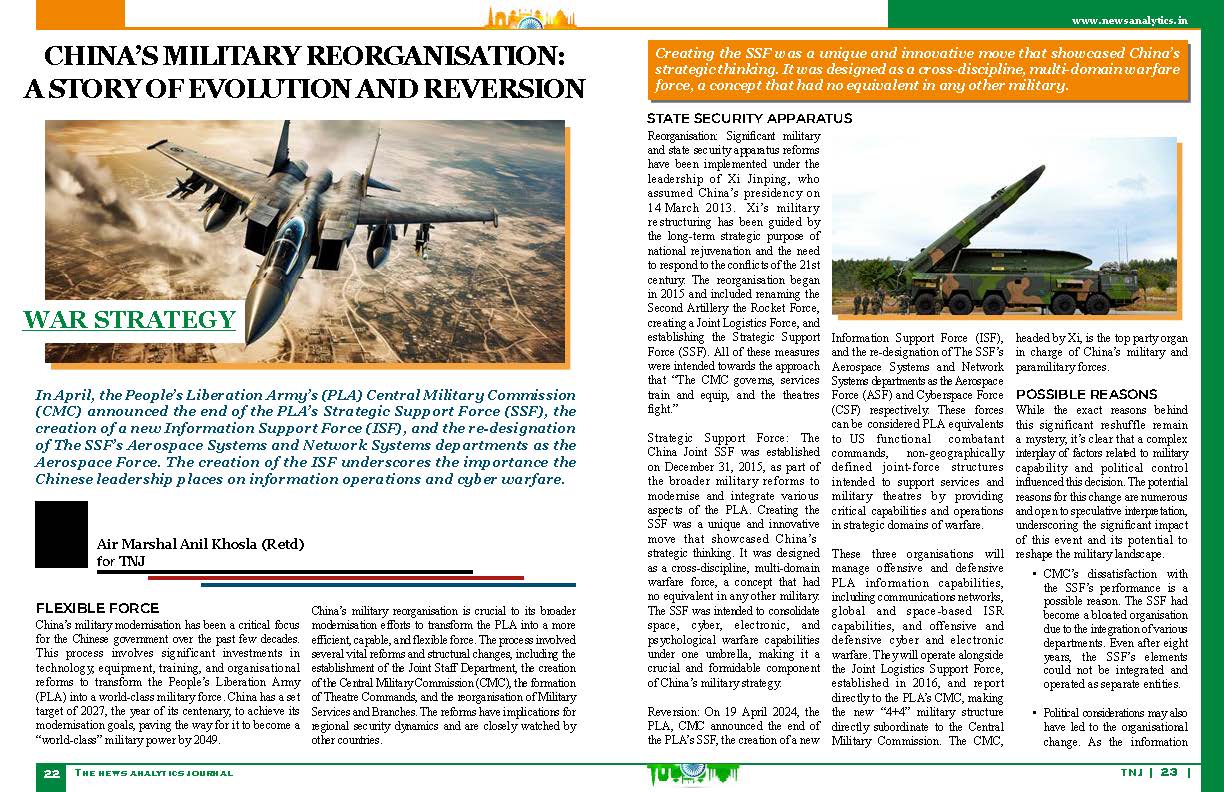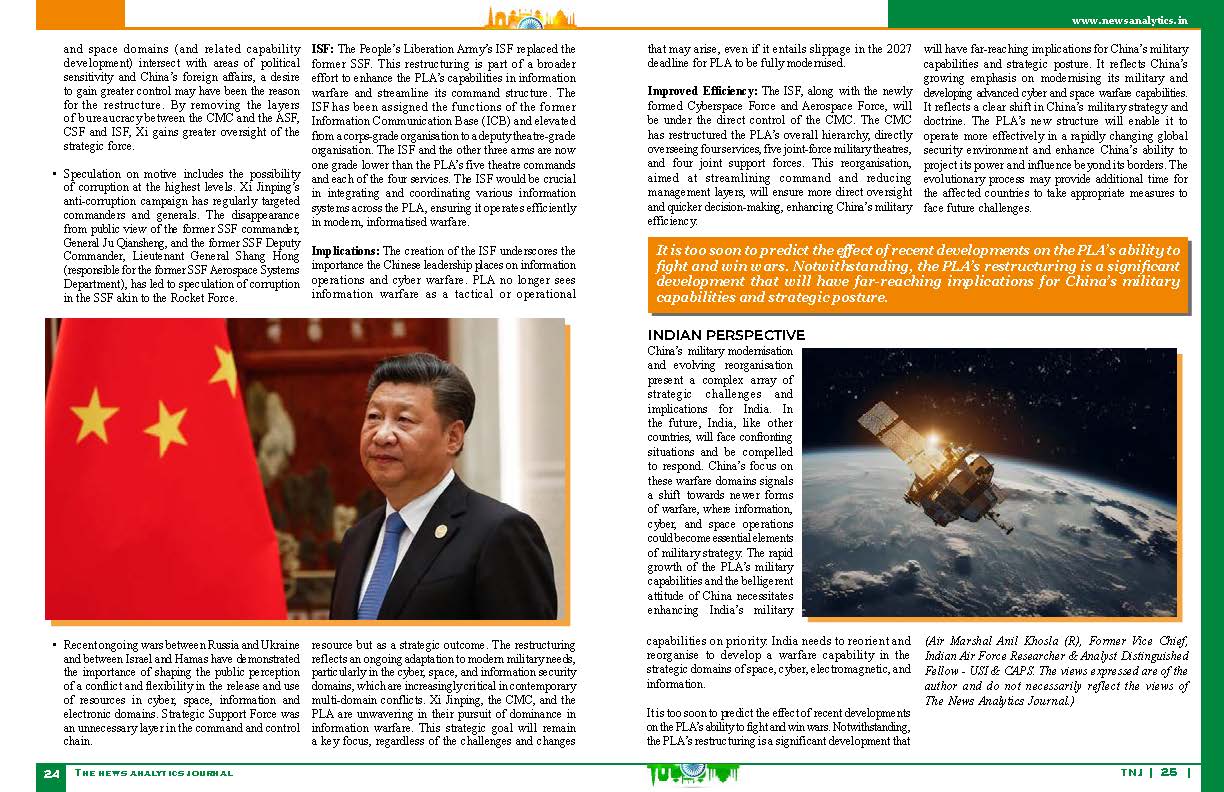


My Article published in the Newsanalytics journal
China’s military modernisation has been a critical focus for the Chinese government over the past few decades. This process involves significant investments in technology, equipment, training, and organisational reforms to transform the People’s Liberation Army (PLA) into a world-class military force. China has a set target of 2027, the year of its centenary, to achieve its modernisation goals, paving the way for it to become a “world-class” military power by 2049.
China’s military reorganisation is crucial to its broader modernisation efforts to transform the People’s Liberation Army (PLA) into a more efficient, capable, and flexible force. The process involved several vital reforms and structural changes, including the establishment of the Joint Staff Department, the creation of the Central Military Commission (CMC), the formation of Theatre Commands, and the reorganisation of Military Services and Branches. The reforms have implications for regional security dynamics and are closely watched by other countries.
Reorganisation. Significant military and state security apparatus reforms have been implemented under the leadership of Xi Jinping, who assumed China’s presidency on 14 March 2013. Xi’s military restructuring has been guided by the long-term strategic purpose of national rejuvenation and the need to respond to the conflicts of the 21st century. The reorganisation began in 2015 and included renaming the Second Artillery the Rocket Force, creating a Joint Logistics Force, and establishing the Strategic Support Force (SSF). All of these measures were intended towards the approach that “The CMC governs, services train and equip, and the theatres fight.”
Strategic Support Force. The China Joint Strategic Support Force (SSF) was established on December 31, 2015, as part of the broader military reforms to modernise and integrate various aspects of the People’s Liberation Army (PLA). Creating the Strategic Support Force (SSF) was a unique and innovative move that showcased China’s strategic thinking. It was designed as a cross-discipline, multi-domain warfare force, a concept that had no equivalent in any other military. The SSF was intended to consolidate space, cyber, electronic, and psychological warfare capabilities under one umbrella, making it a crucial and formidable component of China’s military strategy.
Reversion. On 19 April 2024, the People’s Liberation Army’s (PLA) Central Military Commission (CMC) announced the end of the PLA’s Strategic Support Force (SSF), the creation of a new Information Support Force (ISF), and the re-designation of The SSF’s Aerospace Systems and Network Systems departments as the Aerospace Force (ASF) and Cyberspace Force (CSF) respectively. These forces can be considered PLA equivalents to US functional combatant commands, non-geographically defined joint-force structures intended to support services and military theatres by providing critical capabilities and operations in strategic domains of warfare. These three organisations will manage offensive and defensive PLA information capabilities, including communications networks, global and space-based ISR capabilities, and offensive and defensive cyber and electronic warfare. They will operate alongside the Joint Logistics Support Force, established in 2016, and report directly to the PLA’s CMC, making the new “4+4″ military structure directly subordinate to the Central Military Commission. The CMC, headed by Xi, is the top party organ in charge of China’s military and paramilitary forces.
Possible Reasons. While the exact reasons behind this significant reshuffle remain a mystery, it’s clear that a complex interplay of factors related to military capability and political control influenced this decision. The potential reasons for this change are numerous and open to speculative interpretation, underscoring the significant impact of this event and its potential to reshape the military landscape.
-
- CMC’s dissatisfaction with the SSF’s performance is a possible reason. The SSF had become a bloated organisation due to the integration of various departments. Even after eight years, the SSF’s elements could not be integrated and operated as separate entities.
-
- Political considerations may also have led to the organisational change. As the information and space domains (and related capability development) intersect with areas of political sensitivity and China’s foreign affairs, a desire to gain greater control may have been the reason for the restructure. By removing the layers of bureaucracy between the CMC and the ASF, CSF and ISF, Xi gains greater oversight of the strategic force.
-
- Speculation on motive includes the possibility of corruption at the highest levels. Xi Jinping’s anti-corruption campaign has regularly targeted commanders and generals. The disappearance from public view of the former SSF commander, General Ju Qiansheng, and the former SSF Deputy Commander, Lieutenant General Shang Hong (responsible for the former SSF Aerospace Systems Department), has led to speculation of corruption in the SSF akin to the Rocket Force.
-
- Recent ongoing wars between Russia and Ukraine and between Israel and Hamas have demonstrated the importance of shaping the public perception of a conflict and flexibility in the release and use of resources in cyber, space, information and electronic domains. Strategic Support Force was an unnecessary layer in the command and control chain.
Information Support Force (ISF). The People’s Liberation Army’s Information Support Force (ISF) replaced the former Strategic Support Force (SSF). This restructuring is part of a broader effort to enhance the PLA’s capabilities in information warfare and streamline its command structure. The ISF has been assigned the functions of the former Information Communication Base (ICB) and elevated from a corps-grade organisation to a deputy theatre-grade organisation. The ISF and the other three arms are now one grade lower than the PLA’s five theatre commands and each of the four services. The ISF would be crucial in integrating and coordinating various information systems across the PLA, ensuring it operates efficiently in modern, informatised warfare.
Implications. The creation of the ISF underscores the importance the Chinese leadership places on information operations and cyber warfare. PLA no longer sees information warfare as a tactical or operational resource but as a strategic outcome. The restructuring reflects an ongoing adaptation to modern military needs, particularly in the cyber, space, and information security domains, which are increasingly critical in contemporary multi-domain conflicts. Xi Jinping, the CMC, and the PLA are unwavering in their pursuit of dominance in information warfare. This strategic goal will remain a key focus, regardless of the challenges and changes that may arise, even if it entails slippage in the 2027 deadline for PLA to be fully modernised.
Improved Efficiency. The ISF, along with the newly formed Cyberspace Force and Aerospace Force, will be under the direct control of the Central Military Commission (CMC). The CMC has restructured the PLA’s overall hierarchy, directly overseeing four services, five joint-force military theatres, and four joint support forces. This reorganisation, aimed at streamlining command and reducing management layers, will ensure more direct oversight and quicker decision-making, enhancing China’s military efficiency.
Indian Perspective. China’s military modernisation and evolving reorganisation present a complex array of strategic challenges and implications for India. In the future, India, like other countries, will face confronting situations and be compelled to respond. China’s focus on these warfare domains signals a shift towards newer forms of warfare, where information, cyber, and space operations could become essential elements of military strategy. The rapid growth of the PLA’s military capabilities and the belligerent attitude of China necessitates enhancing India’s military capabilities on priority. India needs to reorient and reorganise to develop a warfare capability in the strategic domains of space, cyber, electromagnetic, and information.
It is too soon to predict the effect of recent developments on the PLA’s ability to fight and win wars. Notwithstanding, the PLA’s restructuring is a significant development that will have far-reaching implications for China’s military capabilities and strategic posture. It reflects China’s growing emphasis on modernising its military and developing advanced cyber and space warfare capabilities. It reflects a clear shift in China’s military strategy and doctrine. The PLA’s new structure will enable it to operate more effectively in a rapidly changing global security environment and enhance China’s ability to project its power and influence beyond its borders. The evolutionary process may provide additional time for the affected countries to take appropriate measures to face future challenges.
Suggestions and value additions are most welcome.
For regular updates, please register here:-
References and credits
To all the online sites and channels.
References:-
- Matt Bruzzese and Peter W. Singer “Farewell to China’s Strategic Support Force”, Defenseone, 28 Apr 2024.
- Dean Cheng, “Why Xi created a new Information Support Force, and why now”, Breaking Defense Indo-Pacific, 29 Apr 2024.
- Kartik Bommakanti, “China removes the PLASSF and establishes ISF: Implications for India”, Observer Research Foundation, 15 May 2024.
- Joe McReynolds and John Costello, “Planned Obsolescence: The Strategic Support Force In Memoriam (2015-2024)”, The Jamestown Foundation, 26 Apr 2024.
- Tenzin Younten, “China’s Latest Military Reorganization Terminates the PLA SSF & launches Three New Arm Forces based on it: Strategic implications of the PLA’s latest Reforms and Structural Changes”, 26 Apr 2024.
- Joe Keary, “Four services and four arms lifts CCP control over information warfare”, Australian Strategic Policy Institute, 24 May 2024.
- Kalpit A Mankar and Satyam Singh, “Tracking China’s moves on information warfare”, Observer Research Foundation, 22 May 2024.
- Amber Wang, “New force for China’s PLA eyes modern warfare information support”, South China Morning Post, 23 Apr 2024.
- Lindsay Maizland, “China’s Modernizing Military”, Council on Foreign Relations, 05 Feb 2020.
Disclaimer:
Information and data included in the blog are for educational & non-commercial purposes only and have been carefully adapted, excerpted, or edited from reliable and accurate sources. All copyrighted material belongs to respective owners and is provided only for wider dissemination.
